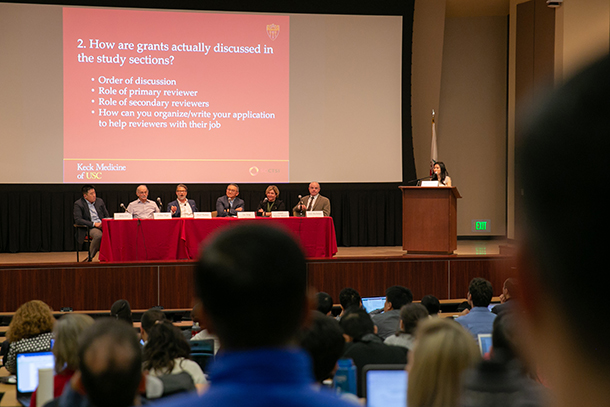When it comes to completing grant applications for the National Institutes of Health, clarity, knowing your audience and the “wow” factor are just some of things to consider. Several experts from the Keck School of Medicine of USC talked extensively on those topics, as well as how to avoid pitfalls in the application process at a recent panel discussion titled “Inside NIH Study Sections and Common Mistakes on NIH Applications: Advice from the Battleground.” The Dec. 18 event was hosted by the Southern California Clinical and Translational Science Institute and the Keck School.
The program began with a presentation by Arthur Toga, PhD, Provost Professor of Ophthalmology, Neurology, Psychiatry and the Behavioral Sciences, Radiology and Engineering, which gave attendees an overview of how to think like a reviewer when filling out NIH applications, and how to present the information about research in an interesting, understandable way in order to get favorable results from the review committee.
Toga reminded the audience that while the application reviewers are scientists, they may not be experts in the same areas that the applicants are. “They may not know everything that you know about your experiment,” he said. “So, you’ve got to explain it to them in a compelling way, in a way that seems enjoyable for them to read.”
A second presentation given by Jerry Lee, PhD, associate professor of clinical medicine and chemical engineering and material sciences, gave insight into the structure of the NIH. Prior to joining the USC faculty, Lee spent more than a decade directing a concept shop within the National Cancer Institute Office of the Director, evaluating and funding more than 2,000 individual R21 grants, R01 grants and team projects.
A panel discussion featured Toga and Lee, who were joined by Paul Thomas, PhD, associate professor of preventive medicine; Jae Jung, PhD, chair and Distinguished Professor of Molecular Microbiology and Immunology; Sarah Hamm-Alvarez, PhD, professor of ophthalmology and pharmacology and pharmaceutical sciences and associate dean for basic and translational research; and Thomas A. Buchanan, MD, professor of medicine, vice dean for research and director of the SC CTSI.
Moderator April Armstrong, MD, professor of dermatology (clinical scholar) and associate dean for clinical research, led a lively discussion in which the panel addressed several questions specific to the application process, including how to approach the application, what the process is for the reviewers, what common mistakes can be easily avoided and how to time the application to give the highest likelihood of funding.
The panel members were able to speak from both the perspective of an applicant and a reviewer, giving the audience insights and pointers on challenges both great and small.
“One of the things that’s really a deterrent as a reviewer is if you uncover sloppiness in some of the sections, where it looks like the work is not particularly tailored for the application or it’s just been put together sloppily,” Hamm-Alvarez stated. “To me, sometimes that indicates that insufficient attention’s been paid to the proposal and insufficient attention might be paid to the science.”
The “wow factor” was mentioned several times by panelists during the discussion. Buchanan explained that the specific aims page of the application should end by leaving the reviewer with a concrete idea of the goals of the research.
“It should end by saying ‘if you accomplish this, here’s what it will mean,’ and I think that’s what the wow factor is. If you say ‘if we accomplish this, we’ll know a little bit more,’ that’s a ‘blah.’” Buchanan instead suggested using a more specific type of statement, such as, “‘If we accomplish this, we’ll have a new biomarker for disease.’ We [reviewers] actually have a target for development of things like that, because more and more translational potential is important to the NIH.”
To view a video of the event, go to http://keckmedia.usc.edu/Mediasite/Play/f3917364e1ff4712912bc29700610b3d1d
— Amanda Busick


